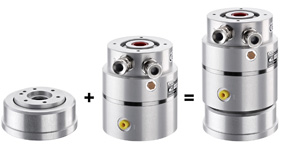
Spring base
for safety brakes

-
Simulation
Spring base
Due to their design principle, SITEMA Safety Brakes can only be released if their clamping system is not under load – which is generally in accordance with the relevant safety regulations. If, however, the load overshoots after switching off the pressure, or moves slightly downward for any particular reason, the Safety Brake is subjected to a partial load. In practice, this means that the load must first be raised before the Safety Brake can be opened and before a movement in load direction is possible.
This effect, often found to be disturbing and time-wasting, can be avoided by not bolting the Safety Brake directly to the machine frame, but rather on top of a spring-base. For its working principle, see the Simulation with spring-base.

Advantages
- Raising the load before any lowering movement is no longer required, even if e.g. a small leakage should occur at the lifting actuators.
- The crucial safety criterion “Safety Brake can only be released if the rod is free of load", is satisfied without restriction. The slightly longer distance for clamping is not relevant for safety.
- The spring-base also compensates for any misalignment between the load guide elements and the clamping rod. Therefore, other compensation techniques are not necessary.
Mounting
The spring-base is factory-mounted on the Safety Brake, ready for use. Special mounting instructions are supplied for retrofitting.
To attach the Safety Brake to the machine frame, threaded holes are provided which are arranged identically to the ones on the Safety Brake.


